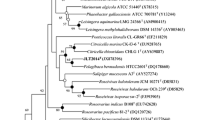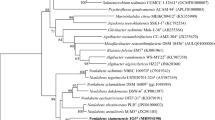Abstract
The Gram-stain-negative, strictly aerobic, curved-to-spiral rod-shaped bacterial strain, designated KN72T, was isolated from the Caroline Seamounts in the Pacific Ocean. Phylogenetic analysis of 16S rRNA gene sequences revealed that strain KN72T was a member of the family Rhodospirillaceae and formed a distinct lineage. Strain KN72T contained ubiquinone-10 as the major respiratory quinone. The polar lipid profiles contained phosphatidylethanolamine, phosphatidylglycerol, one aminolipid and three phospholipids. The predominant cellular fatty acids were C16:0 and summed feature 8 (comprising C18:1ω7c/C18:1ω6c). The strain KN72T displayed highest 16S rRNA gene sequence similarities with Hwanghaeella grinnelliae Gri0909T (92.3%), Marivibrio halodurans ZB80T (91.0%) and Aestuariispira insulae AH-MY2T (90.1%). The DNA G+C content of strain KN72T was 61.1%. Collectively, based on phenotypic, chemotaxonomic, phylogenetic and genomic evidence presented, strain KN72T represents a novel species of a novel genus of the family Rhodospirillaceae, for which the name Pacificispira spongiicola gen. nov., sp. nov. is proposed. The type strain is KN72T (= CGMCC 1.17142T = KCTC 72429T).

Similar content being viewed by others
Availability of data and materials
The datasets generated during and/or analysed during the current study are available from the corresponding author on reasonable request. All data generated or analysed during this study are included in this published article [and its supplementary information files].
References
Altenburger P, Kämpfer P, Makristathis A, Lubitz W, Busse HJ (1996) Classification of bacteria isolated from a medieval wall painting. J Biotechnol 47:39–52
Bligh EG, Dyer WJ (1959) A rapid method of total lipid extraction and purification. Can J Biochem Physiol 37:911–917
Buchfink B, Xie C, Huson DH (2015) Fast and sensitive protein alignment using diamond. Nat Methods 12:59–60
Camacho C, Coulouris G, Avagyan V, Ma N, Papadopoulos J, Bealer K, Madden TL (2009) BLAST+: architecture and applications. BMC Bioinform 10:1–9
Chen S, Xu Y, Zheng C, Ke LX (2017) Marivibrio halodurans gen. nov., sp. nov., a marine bacterium in the family Rhodospirillaceae isolated from underground rock salt. Int J Syst Evol Microbiol 67:4266–4271
Choi DH, Hwang CY, Cho BC (2009) Pelagibius litoralis gen. nov., sp. nov., a marine bacterium in the family Rhodospirillaceae isolated from coastal seawater. Int J Syst Evol Microbiol 59:818–823
Chun J, Oren A, Ventosa A, Christensen H, Arahal DR, da Costa MS, Rooney AP, Yi H, Xu X-W, Meye SD, Trujillo ME (2018) Proposed minimal standards for the use of genome data for the taxonomy of prokaryotes. Int J Syst Evol Microbiol 68:461–466
Dai D, Li Y, He W, Qin F, Zheng J, Sun M, Zhang D (2021) Oceanomicrobium pacificus gen. nov., sp. nov., a member of the family Rhodobacteraceae isolated from seawater of tropical western Pacific. Antonie Van Leeuwenhoek 114:303–311
Dar Jean W, Huang SP, Chen JS, Shieh WY (2016) Tagaea marina gen. nov., sp. nov., a marine bacterium isolated from shallow coastal water. Int J Syst Evol Microbiol 66:592–597
Dong XZ, Cai MY (eds) (2001) Determinative manual for routine bacteriology. Scientific Press (English translation), Beijing
Esposti MD, Lozano L, Martínez-Romero E (2019) Current phylogeny of Rhodospirillaceae: a multi-approach study. Mol Phylogenet Evol 139:106546
Garrity GM, Bell JA, Lilburn T (2005) Family I. Rhodospirillaceae. In: Bergey’s Manual® of systematic bacteriology, vol 2C, pp 1–20. Springer US, pp 1–574
Han SB, Su Y, Hu J, Wang RJ, Sun C, Wu D, Zhu XF, Wu M (2016) Terasakiella brassicae sp. nov., isolated from the wastewater of a pickle-processing factory, and emended descriptions of Terasakiella pusilla and the genus Terasakiella. Int J Syst Evol Microbiol 66:1807–1812
Hördt A, López MG, Meier-Kolthoff JP, Schleuning M, Weinhold LM, Tindall BJ, Gronow S, Kyrpides NC, Woyke T, Göker M (2020) Analysis of 1,000+ type-strain genomes substantially improves taxonomic classification of Alphaproteobacteria. Front Microbiol 11:468
Imhoff JF, Petri R, Suling J (1998) Reclassification of species of the spiral-shaped phototrophic purple non-sulfur bacteria of the alpha-Proteobacteria: description of the new genera Phaeospirillum gen. nov., Rhodovibrio gen. nov., Rhodothalassium gen. nov. and Roseospira gen. nov. as well as transfer of Rhodospirillum fulvum to Phaeospirillum fulvum comb. nov., of Rhodospirillum molischianum to Phaeospirillum molischianum comb. nov., of Rhodospirillum salinarum to Rhodovibrio salexigens. Int J Syst Bacteriol 48:793–798
Kim J, Jeong SE, Khan SA, Jeon CO (2019) Hwanghaeella grinnelliae gen. nov., sp. nov., isolated from a marine red alga. Int J Syst Evol Microbiol 69:3544–3550
Konstantinidis KT, Rosselló-Móra R, Amann R (2017) Uncultivated microbes in need of their own taxonomy. ISME J 11:2399–4063
Kumar S, Stecher G, Tamura K (2016) MEGA7: Molecular evolutionary genetics analysis version 7.0 for bigger datasets. Mol Biol Evol 33:1870–1874
Lai Q, Yuan J, Gu L, Shao Z (2009) Marispirillum indicum gen. nov., sp. nov., isolated from a deep-sea environment. Int J Syst Evol Microbiol 59:1278–1281
Lee I, Kim YO, Park SC, Chun J (2016) OrthoANI: An improved algorithm and software for calculating average nucleotide identity. Int J Syst Evol Microbiol 66:1100–1103
Letunic I, Bork P (2019) Interactive tree of life (iTOL) V4: recent updates and new developments. Nucleic Acids Res 47:256–259
Liao H, Lin XL, Li YQ, Qu MM, Tian Y (2020) Reclassification of the taxonomic framework of orders Cellvibrionales, Oceanospirillales, Pseudomonadales and Alteromonadales in class Gammaproteobacteria through phylogenomic tree analysis. mSystems 15:e00543-20
Liu SW, Ye JJ, Lu QP, Cheema MT, Abbas M, Huang DL, Sajid I, Sun CH (2020) Motilibacter deserti sp. Nov. and Motilibacter aurantiacus sp. nov., two novel actinobacteria isolated from soil of Cholistan Desert and emended description of the genus Motilibacter. Syst Appl Microbiol 43:1261
Liu H, Xin B, Zheng J, Zhong H, Yu Y, Peng D, Sun M (2021) Build a bioinformatic analysis platform and apply it to routine analysis of microbial genomics and comparative genomics. Protoc Exchange. https://doi.org/10.21203/rs.2.21224/v5
Margesin R, Gander S, Zacke G, Gounot AM, Schinner F (2003) Hydrocarbon degradation and enzyme activities of cold-adapted bacteria and yeasts. Extremophiles 7:451–458
Nguyen L-T, Schmidt HA, von Haeseler A, Minh BQ (2015) IQ-TREE: a fast and effective stochastic algorithm for estimating maximum-likelihood phylogenies. Mol Biol Evol 32:268–274
Parks DH, Rinke C, Chuvochina M, Chaumeil PA, Woodcroft BJ, Evans PN, Hugenholtz P, Tyson GW (2017) Recovery of nearly 8,000 metagenome—assembled genomes substantially expands the tree of life. Nat Microbiol 2:1533–1542
Park S, Park JM, Kang CH, Yoon JH (2014) Aestuariispira insulae gen. nov., sp. nov., a lipolytic bacterium isolated from a tidal flat. Int J Syst Evol Microbiol 64:1841–1846
Pfennig N, Trüper HG (1971) Higher taxa of the phototrophic bacteria. Int J Syst Bacteriol 21:17–18
Sasser M (1990) Identification of bacteria by gas chromatography of cellular fatty acids/ Technical Note 101. MIDI Inc, Newark
Satomi M, Kimura B, Hamada T, Harayama S, Fujii T (2002) Phylogenetic study of the genus Oceanospirillum based on 16S rRNA and gyrB genes: emended description of the genus Oceanospirillum, description of Pseudospirillum gen. nov., Oceanobacter gen. nov. and Terasakiella gen. nov. and transfer of Oceanospirillum jannaschii and Pseudomonas stanieri to Marinobacterium as Marinobacterium jannaschii comb. nov. and Marinobacterium stanieri comb. no. Int J Syst Evol Microbiol 52:739–747
Seemann T (2014) Prokka: rapid prokaryotic genome annotation. Bioinformatics 30:2068–2069
Stolz A, Busse HJ, Kämpfer P (2007) Pseudomonas knackmussii sp. nov. Int J Syst Evol Microbiol 57:572–576
Tindall BJ (1990a) Lipid composition of Halobacterium lacusprofundi. FEMS Microbiol Lett 66:199–202
Tindall BJ (1990b) A comparative study of the lipid composition of Halobacterium saccharovorum from various sources. Syst Appl Microbiol 13:128–130
Tully BJ, Sachdeva R, Graham ED, Heidelberg JF (2017) 290 metagenome-assembled genomes from the Mediterranean Sea: a resource for marine microbiology. PeerJ 5:e3558
Wang S, Ye ZH, Wang NN, Mu DS, Du ZJ (2019a) Ferruginivarius sediminum gen. nov., sp. nov., isolated from a marine solar saltern. Int J Syst Evol Microbiol 69:3048–3053
Wang Z, Zhang Z, Li C, Zhang M, Zhao D, Li J, Zhang Y (2019b) Algihabitans albus gen. nov., sp. nov., isolated from a culture of the green alga Ulva prolifera. Int J Syst Evol Microbiol 69:828–832
Wang G, Tang D, Li G, Xu S, Dang G, Su H, Liao Z, Chen B, Huang W, Liang J, Yu K (2020a) Denitrobaculum tricleocarpae gen. nov., sp. nov., a marine bacterium from coralline algae Tricleocarpa sp. Int J Syst Evol Microbiol 70:3335–3339
Wang Q, Liu F, Zhang DC (2020b) Pelagihabitans pacificus gen. nov., sp. nov., a member of the family Flavobacteriaceae isolated from a deep-sea seamount. Int J Syst Evol Microbiol 70:4569–4575
Yoon J, Kang DH (2018) Terasakiella salincola sp. nov., a marine alphaproteobacterium isolated from seawater, and emended description of the genus Terasakiella. Int J Syst Evol Microbiol 68:2048–2053
Yoon SH, Ha SM, Kwon S, Lim J, Kim Y, Seo H, Chun J (2017) Introducing EzBioCloud: A taxonomically united database of 16S rRNA and whole genome assemblies. Int J Syst Evol Microbiol 67:1613–1617
Zheng J, Wittouck S, Salvetti E, Franz CMAP, Harris HMB, Mattarelli P, O’Toole PW, Pot B, Vandamme P, Walter J, Watanabe K, Wuyts S, Felis GE, Gänzle MG, Lebeer S (2020) A taxonomic note on the genus Lactobacillus: Description of 23 novel genera, emended description of the genus Lactobacillus Beijerinck 1901, and union of Lactobacillaceae and Leuconostocaceae. Int J Syst Evol Microbiol 70:2782–2858
Funding
This study was supported by the Science & Technology Basic Resources Investigation Program of China (2017FY100804, awarded to Dechao Zhang), National Natural Science Foundation of China (31670002, awarded to Dechao Zhang), and the Senior User Project of RV KEXUE (KEXUE2019G09, awarded to Dechao Zhang).
Author information
Authors and Affiliations
Contributions
ZDC designed this research, HWX performed strain characterization, phenotypic determination and chemotaxonomic analysis, LYJ performed the genomic and phylogenetic analysis, HWX and LYJ drafted the manuscript. ZDC supervised the study and contributed to text preparation and revised the manuscript. All authors read and approved the final manuscript.
Corresponding author
Ethics declarations
Conflict of interest
The authors declare that they have no conflict of interest.
Ethical approval
This article does not contain any studies with human participants or animals performed by any of the authors.
Additional information
Publisher's Note
Springer Nature remains neutral with regard to jurisdictional claims in published maps and institutional affiliations.
Supplementary Information
Below is the link to the electronic supplementary material.
Rights and permissions
About this article
Cite this article
He, W., Li, Y. & Zhang, D. Pacificispira spongiicola gen. nov., sp. nov., a nitrate-reducing bacterium isolated from tropical western Pacific. Antonie van Leeuwenhoek 114, 2083–2090 (2021). https://doi.org/10.1007/s10482-021-01662-z
Received:
Accepted:
Published:
Issue Date:
DOI: https://doi.org/10.1007/s10482-021-01662-z




